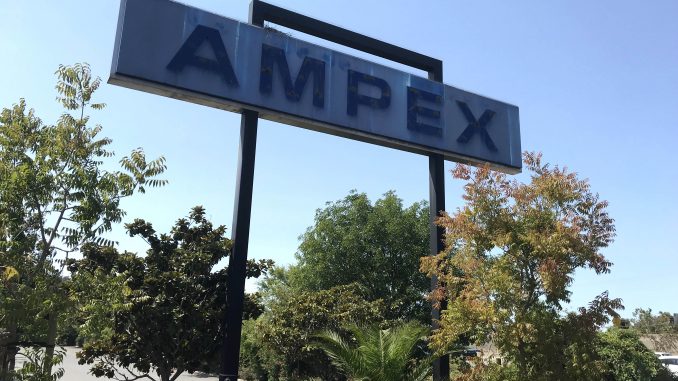
OPINION
BY DAVE PRICE
Daily Post Editor
What would happen if somebody bought the house at 367 Addison Ave. in Palo Alto and decided to tear down the outdated garage where Bill Hewlett and David Packard started Hewlett Packard?
Or if Stanford decided to remove the 150-foot diameter radio telescope dish in the hills above Palo Alto?
Another piece if Silicon Valley history is going away — the 60-year-old Ampex sign that can be seen along Highway 101 in Redwood City.
Last week, crews pulled off the white “Ampex” letters on the sign, and the rest of the sign will be dismantled this week.
The legacy of Ampex
At one time, the sign marked the headquarters of Ampex, the company that pioneered the videotape recorder in the late 1950s.
Ampex alums included Larry Ellison, Atari’s Nolan Bushnell and sound pioneer Ray Dolby.
The videotape recorder transformed television. Before it was invented, everything had to be done live or on film. Not long after it was invented, everything on TV was recorded on tape except for sports, the news and live events.
Ampex won an Oscar, several Emmys and a Grammy.
The original videotape machine, the VR-1000, was the size of an industrial kitchen range and the tape was 2 inches wide.
The technology improved, videotape machines became smaller and smaller, and eventually the reel-to-reel tapes were replaced with cassettes. By the mid-1970s, Japanese manufacturers were turning out consumer models that were the size of a couple of shoe boxes. By the early 1980s, seemingly everybody had a VCR in their home.
Company moves, sign stays put
In 2008, Ampex declared Chapter 11 bankruptcy and was acquired by Delta Information Systems. The company moved to Hayward.
When the company sold off its Redwood City campus, there was a provision in the sale contract that the sign had to stay put.
The property changed hands a couple of times since then. It was the headquarters of Excite At Home in the early 2000s. Now it’s part of Stanford’s growing Redwood City campus, where the adjacent buildings are part of Stanford Health Care’s operation.
Nothing will happen to the HP garage. It’s owned by HP Inc. and has been designated as a U.S. and California historical landmark, meaning the garage can’t be torn down. The Dish, while it’s not on the cutting edge of astronomy, is still being used for academic research. And while all of that metal is ugly, it’s wormed a way into our hearts.
But the Ampex sign isn’t as lucky as the HP garage or The Dish. When Redwood City officials were approving Stanford’s plans for the area along Broadway, the city considered the sign but decided it wasn’t worthy of historic preservation.
New home sought for sign
Stanford spokesman E.J. Miranda said the university is looking for a good home for the sign.
“Stanford has reached out to a variety of local historic societies to see if they had an interest in taking possession of the letters. We also offered the sign to Ampex – who vacated the property years ago. To date, no one has offered to take the sign,” Miranda said in an email to the Post.
Miranda said the size of the letters is a limiting factor in who would be able to take the sign.
He said the sign will be placed in storage. “Our preference is to donate the sign to a historical group or society,” Miranda said. “We are primarily interested in groups that have some affiliation to preserving historic and/or technological elements of the Peninsula.”
It appears Stanford recognizes Ampex’s place in the history of the Valley. While the sign will disappear from view, Miranda said numerous documents, photographs and artifacts from the company are already part of the Special Collections Department of the Stanford Libraries, where they are available for scholarly use by those researching Ampex’s role in the history of technology.
Editor Dave Price’s column appears on Mondays. His email address is [email protected].



They should keep the sign where it is. They should be proud of this place, not trying to sweep it away!
The city should have designated the sign as an historic landmark when it was rolling out the red carpet for Stanford. The city was so generous with Stanford you’d think they could have received preservation of the sign as a concession in return. I wonder if Stanford got such a great deal because Councilman Gee’s company had the university as a client?
My dad who passed away last year worked at Ampex in the 1960’s. That being said…my main memory of the sign was it being vandalized with a giant “T” preceding the “A”.
If the deed for the property included a clause protecting the sign, how did Stanford get the legal right to remove it? The article doesn’t say….
Correction: Ampex filed for bankruptcy in 2008, not 2018.
More about The Dish, which is owned by the U.S. government and operated by SRI International: https://en.wikipedia.org/wiki/The_Dish_(landmark)
My Dad worked for Ampex in the 60’s and had a reel to reel tape player and a slew of tapes for it. He was so proud of it. He passed about 10 years ago and on the few occasions I pass the sign I have such great memories of going to work with him and all the nice people who would give me little jobs to do. I am sorry to see it go.
My dad also worked at AMPEX in the early to mid-1960s. Does anyone else remember that “AMPEX” stood for the founder and his philosophy: “Alexander M. Poniatoff, excellence”? We were so proud of my dad, working for what was a cutting-edge tech company at that time. We owned an Ampex tape recorder/player and had many great music tapes, great round rolls that had to be threaded through the machine’s heads just so, not unlike threading a movie projector or sewing machine. Ampex even sent my dad to England for six months to help set up a factory there.
I am sorry that Stanford — from which, incidentally, both my parents graduated, and where he worked for the remainder of his career — does not deem the Ampex sign historically important enough to leave it up and honor the tech legacy from which they have so richly benefitted. After all, it does not take up much room, right?
My uncle was literally the first or second person hired at Ampex in the 1940’s and built the first American-made audio tape player from stolen Nazi plans. And he too went to Stanford. In the 1950’s he discovered LSD and devoted his life to LSD research, leaving the company in the late 50’s or early 60’s. He is prominently featured in the new Michael Pollan “How To Change Your Mind.” Such an amazing time back then.
Mr. Stolaroff, re your comment “such an amazing time back then”, do you think people were smarter?
I’m surprised no one mentioned amazing Mr. Dolby after his career with Ampex ended. Surely, one notices the Dolby icon scrolling by with the credits of almost every movie made, not to mention Dolby’s marked impact in the tonal quality of sound.
Why not rebuild it near the computer history museum?
One more innovation the Ampex videotape machine brought us was the instant replay! Today the instant replay is officially part of the NFL and MLB officiating systems. (Great innovation though I wish the NFL refs hurried up their replay decisions. Still I’m glad we have it!)
Instant replay had I think a 14 inch platter, about a quarter inch thick that could record 30 seconds of video. And I think ABC got the first few for $300k each. A few years later a couple engineers left and could do almost the same thing and a less than $12k box. Fun time in the industry from mid 70s to mid 80s.
I don’t see why the sign has to be taken down. It doesn’t take up any parking spaces for Stanford’s health services. And it’s not confusing to people. It’s like a metal heritage tree that marks something significant in our past. I realize Stanford isn’t interested in historical preservation. The faculty is pushing to strip historic names off of landmarks like Junipero Serra, hoping to eliminate any vestige of the past. Mao would be pleased by the academics in America who are trying to re-write history.
Thanks for covering this. I worked in the video industry from the late ’70s onward, when everything was done with analog electronics and magnetic tape. Digital video was a pipe dream back then, as we didn’t have the storage or compression technology to make it practical – I’m talking about NTSC/PAL “SD” video, as HDTV was science fiction at that point. During the analog period, Ampex was always at the cutting edge of video technology, but the move to digital (D-1, D-2, D-3, etc.) changed everything, allowing computers and hard drives to take a central role. This eventually opened the door for breakthrough consumer products like DVD, which in turn paved the way for online distribution of films, TV shows and cat videos. None of this would have been possible without the technologies that Ampex and other important companies developed. Cheers to them!
Driving by that iconic old sign always made me think of the old glory days of professional video, when Ampex was a major player. Sad to see it go, but I’m honestly surprised it lasted as long as it did. I wonder how many people in the Valley today know how vital analog VTRs were to both the broadcast TV and post production industries worldwide, as well as their contribution to the tech industry as we know it today.
Again, thanks for recognizing this historic company at Recode.
I agree, there was no need for the sign to come down and they could’ve left it. I wonder about the university sometimes.